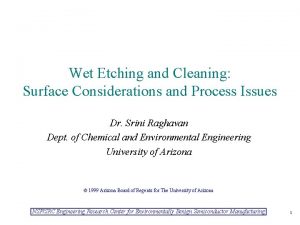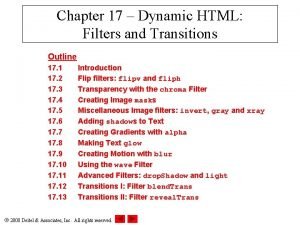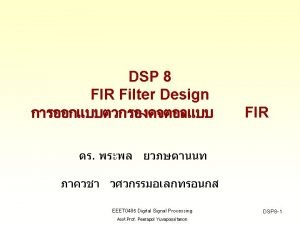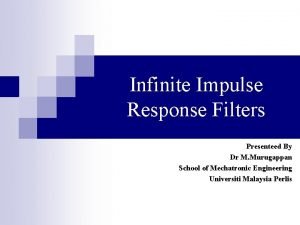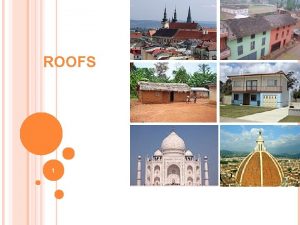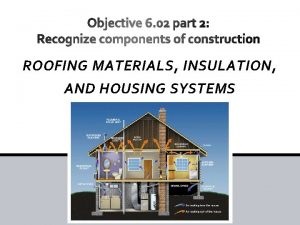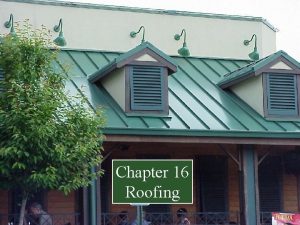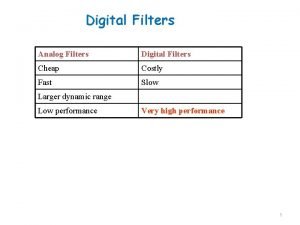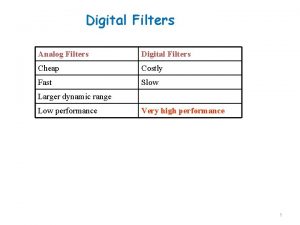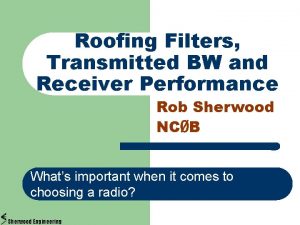Roofing Filters What are they and how do








- Slides: 8

Roofing Filters: What are they, and how do they Help? David Treharne N 8 HKU Ford Amateur Radio League May 8 th, 2014

What is a Roofing Filter • A filter that is just after the first mixer that reduces the passband frequencies allowed into the first IF amplifier, with the goal of reducing the interference effect of strong signals near to the desired signal. – A strong signal can reduce the receiver sensitivity – The mixing products of strong signals can also reduce receiver sensitivity

Normal IF versus Roofing • A normal first IF frequency, in the 9 MHz band, has a pass band of 6 -20 k. Hz. – A 9 MHz IF requires a receiver to upconvert frequencies below the IF and downconvert frequencies above this frequency. • A VHF IF superhet has an IF frequency at 70 MHz, which is very difficult to achieve even this level of passband. Very expensive to create a precise roofing filter. • A roofing filter will have a passband close to the desired signal width, 2. 5 k. Hz or down to several hundred Hz for CW.

AC 0 C Discussion on Roofing Filters • PDF format discussion • The author, Jeff Blaine, also gives an interesting discussion on how a radio without a roofing filter can improve performance in the presence of strong, nearby signals – Turn off any preamps – Add some attenuation, if available.

Super Narrow Filters • Difficult to tune – Must be right on the signal – The received signal had better be frequency stable! – Causes distortion of SSB received voice if narrower than 2. 3 k. Hz to 2. 8 k. Hz. • The filter passes the frequencies within the passband unevenly – Causes ringing – Causes phase delays. RTTY can be affected. More complicated modulation approaches also affected.

In Band Interference • A Roofing filter is no good inside the passband of the receiver. W 9 OY feels a full SDR is better at reducing distortion inside the passband. Note that these are two S 9 signals, representing crowded band conditions. Flat response, no distortion products http: //w 9 oy-sdr. blogspot. com/2009/02/imd-what-imd. html Note the intermodulation products, and curved bandpass, showing distortion.

Recommendations • Most operators who have used a variety of filters recommend: • 2. 3 -2. 8 k. Hz for SSB • 700 Hz for CW and Digital – Common RTTY Mark and Space delta is 170 Hz. • Need 6 k. Hz for AM • Need 15 k. Hz for FM

Last Take • The Quest for a Perfect radio will go on, probably forever. – Part of this is that a good ragchew radio is not the same as a high end contest radio. • Each radio out there has its Promoters and Detractors: – Flex SDR radios difficult to set up, need a Firewire computer hook up, etc. – Elecraft: Some love them, some hate them – Icom: Some 9100 units overheat and shutdown • What have I heard during Field Day? – Radios with a good front end do not get much interference with CW/Digital/SSB on the same band!

